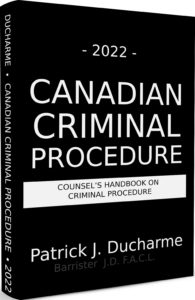
The initial appearance or “arraignment” may be before a Justice or a provincial court Judge. The purpose of the arraignment is to formally present the allegations to the accused. The accused is usually called forward to stand before the Judge, the charge or charges are read to him and he is asked if he is prepared to enter a plea to the charge(s). Before a jury is empanelled, or in the case of a trial by Judge alone, before the case may begin, an accused must be arraigned.
The clerk of the court usually performs the process of calling the accused before the court to read the charges to him. Except in the case of a Corporation, accused persons are expected to attend personally and answer to the charge.1 A corporation, or, as it is referred to now in the Code “an organization”2 appears and pleads by counsel or agent. If there is more than one count in the indictment, each count must be read to the accused separately and his or her plea taken separately on each count. The clerk of the court records each plea.
In Provincial court the plea will be recorded on the back of the Information and in Superior Court the plea will be recorded on the back of the Indictment. The back pages of the Indictment are often used by Judges of the Superior Court to record endorsements that outline each occurrence before the court as the matter makes its way through the various court proceedings prior to and during the trial.

The above is the an excerpt of Patrick J Ducharme’s book, Canadian Criminal Procedure, available at Amazon or in bulk through MedicaLegal Publishing along with Criminal Trial Strategies.
Subscribe to Patrick Ducharme’s Youtube Channel
